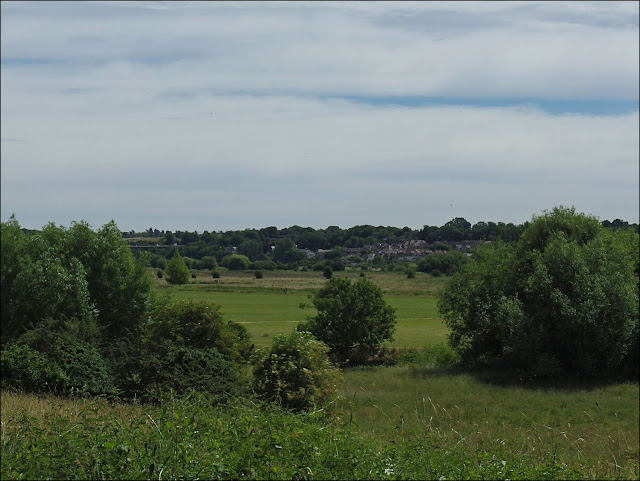The Hertfordshire towns of Hertford and Ware are doing their best to join together and only the valley of the River Lea, which floods in winter, prevents them from doing so. It provides a green breathing space between the two. As soon as I left St Leonard's church behind I found myself on a low bluff overlooking the valley.
The River Lea at this point (in fact for much of its length) is officially known as the River Lee Navigation as it has been adapted to take barges and other boats. The spelling "Lea" or "Lee" is almost interchangeable, though "Lee" is generally used for the man-made features while "Lea" is favoured for the natural features. Generally.
Nowadays its all very peaceful with just the odd leisure craft chugging by. In its heyday however the towns of Hertford and Ware were the heart of the malting and brewing industry and the waterway was busy with cargo boats.
These riverside meadows are known collectively as King's Mead and are managed as a wildlife reserve, being mainly important as a wintering ground for wildfowl.
The watercourse in the above photo is known as the New River, though it's not a river at all but a man-made channel to take clean drinking water from Hertfordshire to London. It's not particularly "new" any more either, having been constructed in 1613! It's still in use today to top up London's reservoirs. The building shown is called the New Gauge and was built in 1856 to measure the amount of water being drawn off from the river.
Today there are many walking and cycling routes following both the River Lee Navigation and the New River through the valley.
Or you can take to the water and paddle your way slowly downstream. If you get good there's always the Lee Valley White Water Centre, just a few miles away in the Olympic Park!
As you get towards Ware there's a unique collection of waterside gazebos, or "Dutch Summerhouses" as they are sometimes known. These were constructed back in the reign of William of Orange when all things Dutch became fashionable. They were mostly built by wealthy merchants who wanted a peaceful place away from the bustling streets of Ware.
And finally, on a small bridge crossing the New River I discovered this old sign, full of just the kind of pompous verbosity that always amuses me.
" ....if the registered axleweights of the several axles of the HEAVY MOTOR CAR and the axle-weights of the several axles of the TRAILER exceed in the aggregate FIVE TONS..."
Sheer poetry!
" ....if the registered axleweights of the several axles of the HEAVY MOTOR CAR and the axle-weights of the several axles of the TRAILER exceed in the aggregate FIVE TONS..."
Sheer poetry!
Take care.










You really do post some fascinating info John and accompanied by good photos - the tourist board need to know about this. Your write up today definitely makes me want to visit.
ReplyDeletePoetry indeed. I guess it wasn’t installed for ordinary folk to read!
ReplyDeleteHi John - lovely area ... and thanks for giving us the history along with some stunning photos - incredible how over time we've engineered our green and pleasant land. Cheers Hilary
ReplyDeleteWonderful history and photos..the 'New' River made me chuckle...
ReplyDeleteBeautiful area, John with lots of history. I love the language used in the sign, it's so interesting to see and read. Great photos too.
ReplyDeleteLovely river!
ReplyDeleteWhat a grand place for a walk. You made me laugh about the "New" river channel, constructed in 1613! Beauty and history all wrapped up in one delightful walk.
ReplyDeleteI am intrigued by your phrase, 'pompous verbocity'--I shall file that in my ragbag mind to await a fortuitous opportunity to trot it out!
ReplyDelete